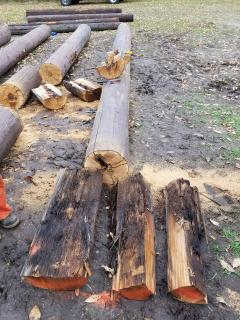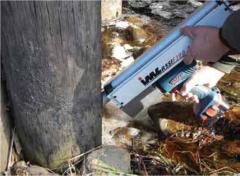# Reducing Wildfires through Better Utility Pole Inspections
Angela Aguero
Forest Products Laboratory
February 3, 2022

Electrical utility pole failure is one of the leading causes of wildfires nationwide. The sheer number of poles involved makes regular inspections challenging – but the Forest Products Lab is finding new ways to carry out pole inspections quickly and easily. (Forest Service photo)
They can pop up almost anywhere.
“They” are wildfires, which can result in loss of human life and lead to billions of dollars of property damage every year in the United States.
Hundreds of failures in electrical utility poles across the nation are one of the leading causes of these disasters. In Idaho alone, nearly 300 wildfires have been caused by utility pole failures in the past 15 years – an average of 20 wildfires every year.
Routine inspection and maintenance would likely reduce the number of wildland fires caused by utility pole failures, but the sheer number of poles and the distances electrical lines span makes regular inspections challenging. One way to reduce this common danger is through better inspections that can be carried out quickly and easily.
To this end, the USDA Forest Service Forest Products Laboratory has joined with the Bureau of Land Management Idaho Boise District and university collaborators to establish more efficient and ultimately life-saving protocols.
Their new report describes strategies that can help expedite the inspection of electric utility poles.

Deterioration caused by decay weakens utility pole structure, a leading cause of wildfire. (Forest Service photo by Xiping Wang)
“We’ve come so far compared to what we had to work with just 20 years ago,” said Robert (Bob) Ross, research general engineer at the Forest Products Laboratory and one of the lead authors of the study. “Where we once could only rely on probing with pocketknives, drilling, and simply eyeballing the wood in utility poles, we can now use a variety of advanced scientific tools and techniques that provide more data with greater efficiency and less invasiveness.”
Two technologies originally researched 40 to 50 years ago are now more widely available to inspect wood structures. The first involves measuring the rate at which sound waves travel through wood. Sound waves travel more quickly through decayed wood than solid wood. Inspectors can now rapidly detect deteriorated poles using small, portable stress-wave testing equipment.
The second advancement involves the use of micro drilling to detect decayed wood, which typically offers less resistance to the drill than uncompromised wood. By observing the resistance of a tiny drill bit as it penetrates the wood pole, inspectors can quickly identify poles that are structurally sound and those that are not. Although test drilling is usually driven straight across wood grain, it can take also take place at an angle to assess the area below the ground line of utility poles and other outdoor wooden structures.

By observing the resistance of a tiny drill bit as it penetrates the wood, inspectors can quickly identify poles that are structurally sound and those that are not. (Forest Service photo by Christopher Senalik)
Ross and other scientists predict that these advanced approaches to inspecting utility poles will result in far fewer wildfires, greatly reduced expenses – and most importantly, many lives save